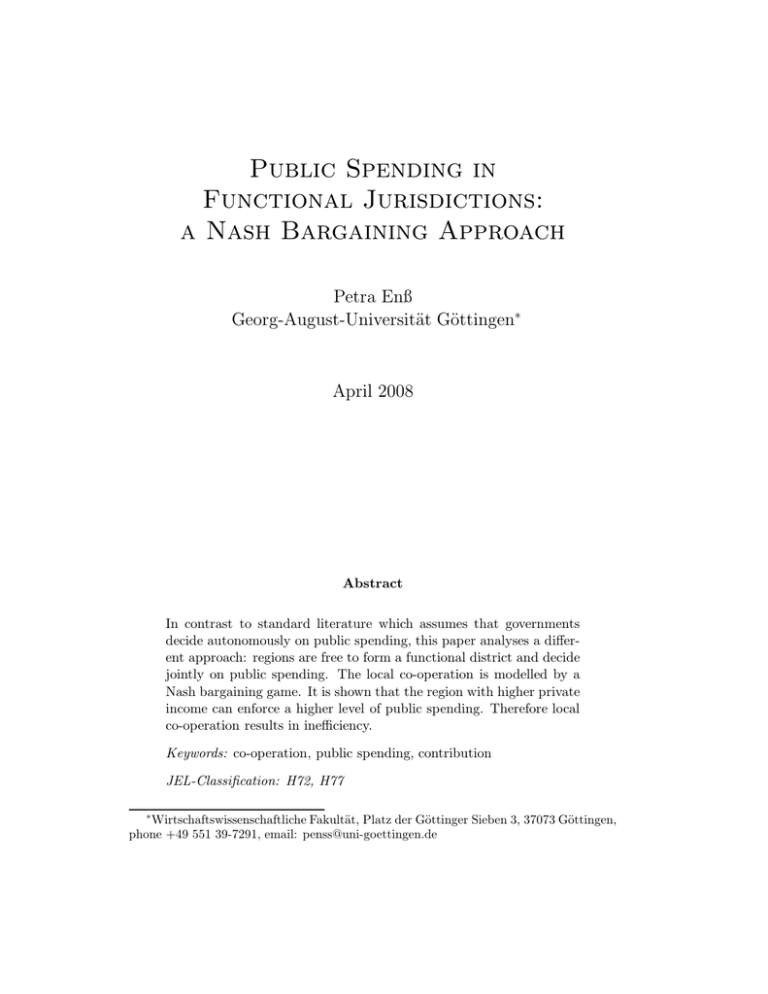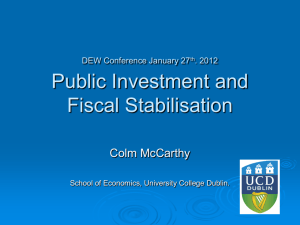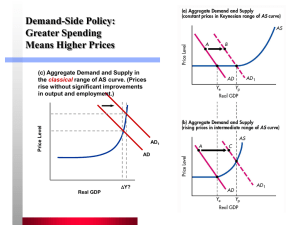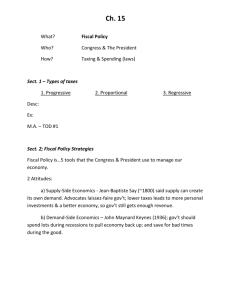Public Spending in Functional Jurisdictions: a Nash Bargaining Approach Petra Enß
advertisement

Public Spending in Functional Jurisdictions: a Nash Bargaining Approach Petra Enß Georg-August-Universität Göttingen∗ April 2008 Abstract In contrast to standard literature which assumes that governments decide autonomously on public spending, this paper analyses a different approach: regions are free to form a functional district and decide jointly on public spending. The local co-operation is modelled by a Nash bargaining game. It is shown that the region with higher private income can enforce a higher level of public spending. Therefore local co-operation results in inefficiency. Keywords: co-operation, public spending, contribution JEL-Classification: H72, H77 Wirtschaftswissenschaftliche Fakultät, Platz der Göttinger Sieben 3, 37073 Göttingen, phone +49 551 39-7291, email: penss@uni-goettingen.de ∗ 1 Introduction This paper examines public spending in functional jurisdictions such as special purpose districts in the United States or Canada or Landkreise in Germany. Municipalities or residents form these districts in order to secure the provision of a common public good.1 A central argument for local cooperation is reducing costs. This paper focuses on the possibility to attain economies of scale. To finance public spending, functional districts either levy a tax on a regional tax base or set a contribution on local tax revenue. Local co-operation can be voluntary or enforced by a central government.2 Irrespective of the reason for co-operation it is a possibility to align public spending with local requests. Some public goods can not be offered by a region on its own. In this case functional districts are an alternative to centralization and allow a better response to local needs. Public spending in functional districts is not an autonomous decision of a government or a legislature but instead a joint decision of regional policy makers. Therefore this paper models regional co-operation by a Nash bargaining game. It is shown that a central government ignores the effect on private consumption in a region with higher income and redistributes welfare to some extent. In a co-operation both partners have to agree to an allocation and from there achieve an enhancement. With restricted policy instruments this can cause a higher level of public spending in the wealthy region. In a related paper Persson and Tabellini (1996) come to a similar result. They analyse bargaining between regions about an insurance system. If the regions face different risks of suffering income shocks the one with the better risk will use its bargaining power to prohibit redistribution to some extent. Fenge and von Weizsäcker (2001) emphasize the importance of the threat point in a similar model. Eggert and Haufler (1998) point out the role of asymmetric capital endowment. They show that small countries are less willing to co-operate in tax competition. The paper is structured as follows. The next section introduces a simple model. Section 3 examines the allocations of a central planner and a functional district within full fiscal instruments, while in section 4 these are re1 Frey and Eichenberger (2000) introduce with Functional Overlapping Competing Jurisdictions a related form of governments. 2 Both forms of co-operations can be found, e.g. German states enact Landkreise, which are a compulsive co-operation of municipalities. Special purpose districts in the United States are optional. 1 stricted. Section 5 concludes the paper. 2 The Model A federal economy consists of two regions i = 1, 2. In each region, a representative resident earns a fixed income si . In addition to private consumption ci , she consumes a public good gi , and thus the residents’ utility function is ui = u(ci, gi ) = ci + b(gi ) (1) with b0 (gi) > 0 and b00 (gi ) < 0. The public good gi is offered either by a local, or a central government. The cost function K of the public good is linear so that K = α · gi + F, (2) α > 0, where α represents the marginal costs and F are fix costs. To finance gi , a contribution of the rate ϑi is levied on the local tax base si . The contribution rate can also be interpreted as a tax rate on si . The private consumption in region i is given by ci = si (1 − ϑi ). (3) In order to consider unequal allocations of private income, s1 > s2 is assumed throughout this paper. Therefore region i = 1 is called the rich region , region i = 2 is called the poor region. Two institutional settings, a central government and a decentralized federation, are analysed. The central government determines the contribution of the region as well as the allocation of the public good. In a decentralized federation regions can either offer public goods on their own or form a functional district. For a co-operation the local partners have to agree to a cost apportionment and to an allocation of public goods. If the local governments do not agree to a bargaining solution, they offer public goods on their own. The regions then maximize their residents’ utility ui subject to the local budget constraint ϑi si = αgi + F . The utility in the threat point is ui = si − α · gi − F + b(gi ). (4) From the first order condition one can show that gi = g ∗ satisfies b0 (g ∗) = α. It is assumed that b0 ( si −F ) ≤ α ≤ b0 (0), so the public good is offered and α private consumption is positive in both institutional settings. 2 The budget of the central government and the functional district is ϑ1 s1 + ϑ2 s2 = α(g1 + g2 ) + F. (5) Central and local policy makers can set gi independent of the share of contribution. The public good is a local one with no spillovers to the other region. A current example for such joint public spending is waste management. In this case the allocation of gi can be interpreted as the share of capacity claimed by a region. While by a utilitarian maximization, regions have no influence on allocations chosen by the central government, the partners of a functional district are free to accept an outcome of a bargaining process. Considering utility maximization of local players there is always a bargaining solution. The benefit of common public spending is the sharing of fix costs and with it decreasing costs per unit of the public good. 3 The Optimum As a benchmark case the central government maximizes the sum of the utilities w = u1 + u2 over the contribution rates ϑi and the public good allocation gi subject to the common budget (5): max s1 (1 − ϑ1 ) + b(g1 ) + s2 (1 − ϑ2 ) + b(g2 ) ϑi ,gi (6) s.t. ϑ1 s1 + ϑ2 s2 = α(g1 + g2 ) + F. From the first order conditions it follows that the public spending is uniform in the regions, so b0 (g1 ) = b0 (g2 ) = α. Therefore the optimal level of the public good g ∗ is offered in both regions. In order to finance public spending the sum of contributions must equal ϑ1 s1 + ϑ2 s2 = 2α · g ∗ + F. (7) The central government is indifferent to all possible allocations of private consumption, so there is a set W1 of solutions. All of them have to satisfy equation (7). 3 In a functional district, local governments maximize the Nash product n = (u1 − u1 )(u2 − u2 ) subject to the common budget: max (s1 (1 − ϑ1 ) + b(g1 ) − u1 )(s2 (1 − ϑ2 ) + b(g2 ) − u2 ) ϑi ,gi (8) s.t. ϑ1 s1 + ϑ2 s2 = α(g1 + g2 ) + F. Using the first order conditions it can be shown that b0 (g1 ) = b0 (g2 ) = α holds again. Public spending is therefore first best efficient. But instead of a set of first best efficient allocations, the bargaining process defines a unique outcome N1 . From the first order conditions it follows u1 − u1 = u2 − u2 . Since g ∗ is equal in the threat point and in N1 one can show that ϑ1 s1 = ϑ2 s2 . (9) The bargaining solution N1 is contained in the solution of the central planner W1 . The allocation of public goods and private consumption is unique. With s1 > s2 , it follows that ϑ1 < ϑ2 . While the payments are equal in both regions, the contribution rate in the rich region is smaller. Proposition 1 The bargaining solution N1 of a functional district is an allocation with uniform public spending in the regions. While the contribution rate of the rich region is smaller than the one of the poor region, the payments of both partners are equal in absolute terms. N1 is an element of W1 and therefore first best efficient. 4 Restricted fiscal instruments Some federations encourage local co-operations, but they dictate that regions should be treated equally.3 The reason for this might be ideological. The political economy provides another argument for uniformity: Wrede (2006) argues uniformity protects small regions against a central government. Being forced to treat all regions equally gives a central government no possibility to form a minimum winning coalition and regions can not be played off against 3 For example the Germen States Bavaria, Baden-Württemberg and MecklenburgVorpommern dictate their Landkreisen to set uniform contribution rates. 4 each other. This can justify restrictions of fiscal instruments . In addition they can also be understood as a protection of local governments. Regions can still decide freely on the public good allocation but they have to agree on a uniform ϑ. The restriction of instruments decreases the set of possible allocations. To find all Pareto efficient allocations, it is necessary to maximize the utility of one region subject to a given utility ûi of the other region and the budget of the regional co-operation: max s2 (1 − ϑ) + b0 (g2 ) ϑi ,gi (10) s.t. s1 (1 − ϑ) + b0 (g1 ) = ub1 and ϑ(s1 + s2 ) = α(g1 + g2 ) + F. To solve this problem the envelope theorem is used. The result is the sum of all Pareto efficient allocations. It can be shown that the slope of the Pareto frontier P is always −µ = −b0 (g2 )/b0 (g1 ) (11) with µ as the Lagrange operator of the first side condition. So the gradient of P is only determined by the allocation of gi . Furthermore dϑ =0 du1 (12) holds. Therefore the sum of public goods does not vary along the Pareto frontier and there exists exactly one welfare maximizing ϑ∗ . All Pareto efficient solutions of the bargaining game will differ only in the allocation of public spending but not in the sum of contributions of the regions. These two results imply a strictly concave Pareto frontier. Proposition 2 In a setting with restricted fiscal instruments, such as a uniform contribution rate, both a central government and a functional district will choose exactly one ϑ∗ . The total amount of public spending in the federation is thus constant and independent of the institutional setting. 5 The utilitarist maximizes w over a uniform contribution rate and the public good provision: max s1 (1 − ϑ) + b(g1 ) + s2 (1 − ϑ) + b(g2 ) ϑ,gi (13) s.t. ϑ(s1 + s2 ) = α(g1 + g2 ) + F. Looking at the first order conditions b0 (g1 ) = b0 (g2 ) = α holds again. But due to the uniform ϑ, the contribution of each region i is fixed to ϑ= 2α · g ∗ + F . s1 + s2 (14) The allocation W2 is contained in W1 and from there it is first best efficient. Furthermore it is unique. Since b0 (g1 ) = b0 (g2 ), the gradient of the Pareto frontier in W2 is µ = −1. In the case of regional co-operation, the local partners maximize the Nash product n over a uniform contribution rate ϑ and gi , subject to the budget of the functional district: max (s1 (1 − ϑ) + b(g1 ) − u1 )(s2 (1 − ϑ) + b(g2 ) − u2 ) ϑ,gi (15) s.t. ϑ(s1 + s2 ) = α(g1 + g2 ) + F. Using the first order conditions one can show b0 (g2 )[s1 (1 − ϑ) + b(g1 ) − u1 ] = b0 (g1 )[s2 (1 − ϑ) + b(g2 ) − u2 ]. (16) With an unequal allocation of private income, s1 > s2 , it follows g1 > g2 in the bargaining solution N2 . Since the sum of public spending is constant 2·g ∗ along the Pareto frontier, the same contributions are chosen in N2 as in W2 . Hence the private consumptions si (1 −ϑ) in a centralized and a decentralized federation are equal. The allocation N2 is efficient in the sense of a bargaining game but differs from the first best solution. The reason for non-uniform public spending is the limitation of fiscal instruments. While the contribution rate is now equal for both regions, the absolute payment of the rich region is higher. A central government ignores the effect on the private consumption 6 u2 A P W2 N2 N1 u2 W1 B u1 u1 Fig. 1: Allocations in different institutional settings and therefore redistributes welfare to some extent. But in order to find a compromise in a functional district, the rich region needs to be compensated. Since there is no possibility to reimburse with a lower contribution rate, the compensation is paid in terms of public goods. Therefore g1 > g2 must be satisfied, even though inefficiency in public spending arises. Figure 1 pictures all solutions. The straight line AB is the set of first best efficient allocations W1 a central government will choose assuming varying contribution rates and public good provision. The Nash bargaining solution in the same setting is N1 . Obviously N1 is a point on the straight line AB and is therefore contained in W1 . The curve P is the Pareto frontier for 7 the settings with a uniform contribution rate. W2 is the allocation a central government will choose with limited fiscal instruments. Since ϑ < 1, W2 is below the intersection of the Parteo frontier P and the 45◦ line through origin. Therefore the utility between the regions has not been totally equalized, but the differences have been reduced. Even though N2 is efficient in sense of a bargaining solution, the aggregated surplus is smaller than in N1 or W2 . Proposition 3 In a functional district with a uniform contribution rate the rich region can enforce a higher level of public spending than the poor region (g1 > g2 ). A result of local co-operation is inefficiency in public spending. Comparing residents’ utility, the institutional settings ‘centralization’ and ‘functional district’ can be evaluated. Restrictions of fiscal instruments must be taken into account. Only the situation, in which a federation is centralized and fully instrumented, can not be evaluated because it is not unique. UiW2 is the utility of the resident in region i under a central government regime with a uniform contribution rate. UiN1 is the utility for a resident settled in a functional district with unequal contribution rates and UiN2 is the utility for residents in a functional district with restricted fiscal instruments. Comparing residents’ utility it turns out that U1N1 > U1N2 > U1W2 (17) U2N1 < U2N2 < U2W2 . Generally, the situation of the region with higher utility in the threat point is better off in a functional district than under a central government. The reason can be seen in the need to consider a better fallback position in a bargaining solution while the central government pays no attention to it. The bargaining solution leads to an equal share of welfare improvement for both regions. In a co-operation the better threat point of the rich region is either compensated by a lower contribution rate or a higher share of the public good provision. The direct way of compensation is a lower contribution rate because it influences the private consumption and does not lead to inefficiencies in the public sector. Compensation through higher public spending is not effective because inefficiencies arise. Hence the first best allocation cannot be reached anymore. 8 5 Conclusion While the standard assumption in literature is either a central or a local government deciding autonomously on public spending, this paper analyses a different approach: regions are free to form a functional district in order to attain economies of scale in the provision of public goods. Therefore local governments need to decide jointly on contribution rates as well as on the allocation of public goods. While in a setting with full fiscal instruments first best efficiency can be achieved by both institutional arrangements, a functional district can only achieve second best efficiency when fiscal instruments are restricted. The bargaining process considers the individual situation of each region in its threat point. The possibilities to reallocate private consumption are restricted and either the contribution rate of the rich region is smaller or public spending is higher. Since different forms of functional districts exist in federations, the policy implication might be that these must be able to set the design of their cooperation freely. While many national and sub-national governments promote local co-operations, they often fail to permit a high degree of freedom in terms of fiscal instruments. Literature Eggert, W and A. Haufler, 1998, When Do Small Counties Win Tax Wars?, Public Finance Review 26, 327-361. Fenge, R. and J. v. Weizsäcker, 2001, How Much Fiscal Equalization? A Constitutional Approach, Journal of Institutional and Theoretical Economics 157, 623-633. Frey, B.S. and R. Eichenberger, 2000, Towards a New Kind of Eurofederalism, in: Bouckaert, B. and A. Godart - van der Kroon (eds.), Hayek Revisited, Cheltenham: Edward Elgar, 138-153. Persson, T. and G. Tabellini, 1996, Risk Sharing and Redistribution, The Journal of Political Economy 104, 979-1009. Wrede, M., 2006, Uniformity Requirement and Political Accountability, Journal of Economics 89, 95-113. 9







